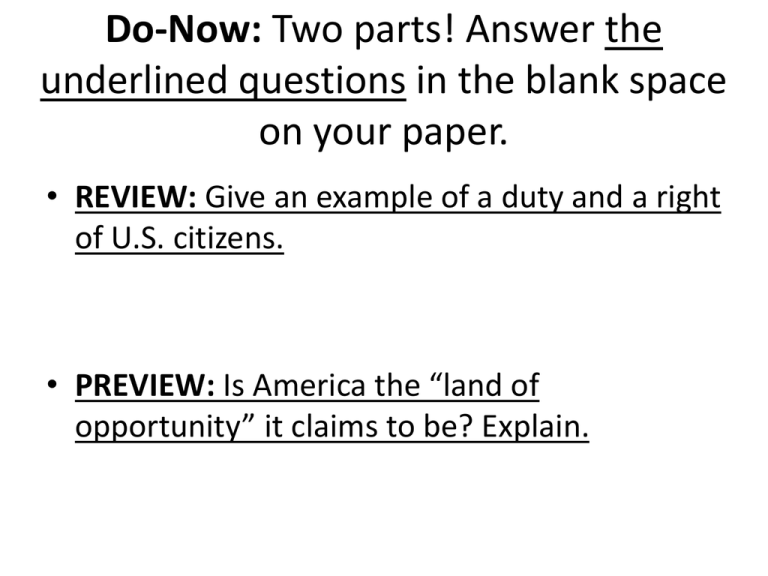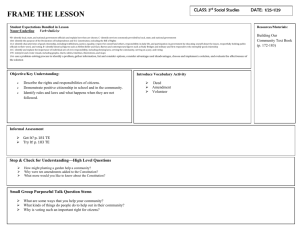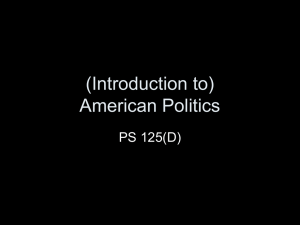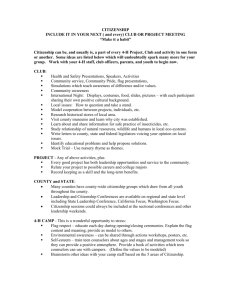Immigration and diversity
advertisement

Do-Now: Two parts! Answer the underlined questions in the blank space on your paper. • REVIEW: Give an example of a duty and a right of U.S. citizens. • PREVIEW: Is America the “land of opportunity” it claims to be? Explain. REVIEWING AND DEEPENING: Yesterday’s lesson What do YOU think? Rights and Responsibilities Do rights and responsibilities ever overlap? YES! Is voting a right? Is voting also a responsibility? Do they ever conflict? YES! What if you yelled “FIRE!” in a crowded movie theater when there wasn’t one? What RIGHT might be involved? What RESPONSIBILITY might be involved? In the crowded movie theater scenario, which is more important: The right? Or the responsibility? The responsibility. Even though you have a right to free speech, you have the responsibility to protect the public safety. It would be seriously unsafe to yell “FIRE!” in a crowded movie theater… Reflect… Thumbs Up or Down? As we click through each slide, give a thumbs up if a statement is true or a thumbs down if a statement is false. Reflect… Thumbs Up or Down? The Constitution lists US citizens’ liberties in the Bill of Rights. Reflect… Thumbs Up or Down? Students and adults have the same rights. Reflect… Thumbs Up or Down? While we have many rights, that also means that we have many responsibilities. Reflect… Thumbs Up or Down? Rights and responsibilities sometimes overlap and sometimes conflict. TODAY: Diversity and Immigration DIVERSITY • What is diversity? http://www.youtube.com/watch?v=Lmj9HnbdhTc • NO. How would YOU define diversity? – Turn and talk: talk with a partner QUIETLY (the other side of the room should not be able to hear you!) – Write down your thoughts around the term diversity as a brainstorm. (See whiteboard.) • Has your definition of diversity changed now? How? • In what ways can we be diverse? • Think: Does Vance have a diverse student body? – Share out. Understanding Diversity • Diversity- the differences between a group of people, places, or things • Types of diversity: – Religion – Race – Wealth – Gender – Sexuality – Socio-economic status • How do we see diversity within this classroom? History of Diversity in the U.S. • America is a nation made of immigrants. • Written on the Statue of Liberty: Give me your tired, your poor, Your huddled masses yearning to breathe free, The wretched refuse of your teeming shore. Send these, the homeless, tempest-tost to me, I lift my lamp beside the golden door!“ • What does this mean? IMMIGRATION and NATURALIZATION • BY PAPERS: applying for citizenship, one of the methods for becoming a citizen of the US – Recall: What are the other methods? • Naturalization: the process of applying for and earning citizenship in a country by meeting certain standards – It is VERY difficult to be naturalized! – Steps: 1. 2. 3. 4. 5. 6. Sign statement Live in US for 5 yrs (green card) Be over 18 yrs old, live in state for at least 3 months Interview Citizenship exam Oath of allegiance Sample Citizenship Test 1. What are the Colors of our flag? 2. How many stars are in our flag? 3. What color are the stars on our flag? 4. What do the stars on the flag mean? 5. How many stripes are on the flag? 6. What color are the stripes? 7. What do the stripes on the flag mean? 8. How many states are there in the Union? 9. What is the 4th of July? 10. What is the date of Independence Day? 11. From what country did the colonies declare Independence? 12. What country did we fight during the Revolutionary War? 13. Who was the first President of the United States? 14. Who is the President of the United States today? 15. Who is the Vice President of the United States? 16. Who elects the President of the United States? 17. Who becomes President of the United States if the President should die? 18. For how long do we elect the President? 19. What is the Constitution? 20. Can the Constitution be changed? 21. What do we call a change to the Constitution? 22. How many changes or amendments are there to the Constitution? 23. How many branches are there in our government? 24. What are the three branches of our government? 25. What is the legislative branch of our government? 26. Who makes the laws in the United States? 27. What is Congress? 28. What are the duties of Congress? 29. Who elects Congress? 54. How many Supreme Court Justices are there? 55. Why did the Pilgrims come to America? 56. What is the head executive of a state government calle 57. What is the head executive of a city government called 58. What holiday was celebrated for the first time by the American Colonists? 59. Who was the main writer of the Declaration of Independence? 60. When was the Declaration of Independence adopted? 61. What is the basic belief of the Declaration of Independence? 62. What is the national anthem of the United States? 63. Who wrote the Star Spangled Banner? 64. Where does freedom of speech come from? 65. What is the minimum voting age in the United States? 66. Who signs bills into law? 67. What is the highest court in the United States? 68. Who was President during the Civil War? 69. What did the Emancipation Proclamation do? 70. What special group advises the President? 71. Which President is called the “Father of our Country"? 72. What Immigration and Naturalization Service form is u to apply to become a naturalized citizen? 73. Who helped the pilgrims in America? 74. What is the name of the ship that brought the Pilgrims America? 75. What were the thirteen original states of the U.S. called 76. Name three rights or freedoms guaranteed by the Bill o Rights? 77. Who has the power to declare war? 78. What kind of government does the United States have? 100 questions to study, 10 questions on the test randomly… COULD YOU PASS THIS TEST? HISTORY OF CITIZENSHIP • Native Americans: not until 1924 did the US make all Native Americans citizens (before that, citizenship given to those who gave up their traditional culture) • African-Americans: given citizenship in 1868 • Women: were given citizenship early, but not allowed to vote until 1920 • 14th Amendment: part of the Constitution passed in 1868 that gave everyone born or naturalized in the US the same rights MULTICULTURALISM • Multiculturalism: the idea that having many different cultures, groups, and lifestyles strengthens America • TWO THEORIES OF MULTICULTURALISM: • Melting Pot Theory: when immigrants come to America they should melt into one American society (be like everyone else) – Examples: Immigrants should all speak English, Native Americans should cut their hair • Salad Bowl Theory: immigrants should keep their unique cultures and differences but also join into American society – Ex. Little Italy, Chinatown, Little Haiti VS. WHICH THEORY? WHICH THEORY? WHICH THEORY? WHICH THEORY? WHICH THEORY? WHICH THEORY? Which theory? • In your opinion, which theory is more correct considering the reality of the US: Melting Pot or Salad Bowl? • Answer the question in complete sentences in your notes. VS. • ANSWER: 1. 2. 3. How does Uncle Sam seem to feel about diversity? How does Uncle Sam seem to feel about immigration? Thinking about diversity, why do you think they show the pot bubbling over so much? PROS and CONS: • What are the pros and cons of having a diverse society? Brainstorm with a partner and fill in the chart. PROS (+) CONS (-) PROS • • • • Living up to US values like equality, acceptance, etc. Learning new ideas and being more globally aware Gaining new cultural traits. (Ex: Diverse food selection) Affirmative action: created to help minorities receive equal opportunity in schools and the workplace. • What else? CONS • ISMs – Racism, sexism, ageism • Stereotypes – http://www.sensonize.com/google-suggestsstereotypes/ • Conflict • Discrimination • Bias: unfair preferences for or against something (can be positive or negative) How can we effectively participate in a diverse society? • Tolerance, accepting of differences, and respecting other cultures, races, sexes, and so on. – In order to do this we need to begin talking about race, ethnicity, and differences in order to learn about one another. • UNFORTUNATELY… All of us have some type of generalizations formed in our heads about what race and ethnicity mean. • Let’s play a game… Guess My Race • You will be shown several pictures …guess which race the person belongs to… Guess My Race? • In groups of three, you will go around the room and try to guess the race of each of the people pictured. • You must AGREE as a group. • We will go over this when we are done! Crossing the Line Activity • We will perform this activity in the space at the front of the classroom. – Line up along the board behind the tape line. • Must be positive and enthusiastic • If you do not feel comfortable responding to one of the prompts, you do not need to. EXIT TICKET • Create your own US Citizenship Test based on what you think citizens should know. – Think: Do you know all this information? You can include questions that you don’t know the answer to.




